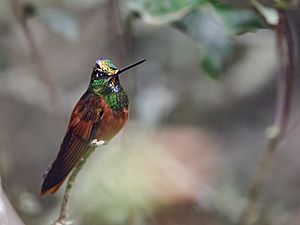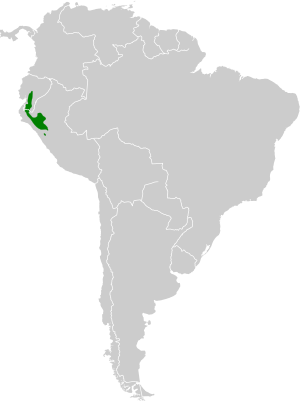Rainbow starfrontlet facts for kids
Quick facts for kids Rainbow starfrontlet |
|
|---|---|
 |
|
| Conservation status | |
| Scientific classification | |
| Genus: |
Coeligena
|
| Species: |
iris
|
 |
|
| Synonyms | |
|
|
The rainbow starfrontlet (Coeligena iris) is a beautiful type of hummingbird. These tiny birds are known for their bright, shimmering colors. You can find them living in the mountains of Ecuador and Peru. They belong to a group of hummingbirds sometimes called "brilliants."
Contents
Different Types of Rainbow Starfrontlets
Just like there are different kinds of dogs, there are different kinds of rainbow starfrontlets. Scientists call these different types "subspecies." The rainbow starfrontlet has six known subspecies:
- C. i. hesperus
- C. i. iris
- C. i. aurora
- C. i. flagrans
- C. i. eva
- C. i. fulgidiceps
Some of these subspecies look quite different from each other. Scientists are still studying them. They want to see if some of these types might actually be separate species one day.
What Does the Rainbow Starfrontlet Look Like?
The rainbow starfrontlet is a small bird, about 12.5 to 14 centimeters (5 to 5.5 inches) long. Males are a bit heavier than females. Both male and female birds have a long, straight, black beak. The female's beak is usually a little longer.
You can spot a white dot behind each of their eyes. Both sexes also have a tail that splits into two points, like a fork. The male's tail is more deeply forked than the female's.
Male Rainbow Starfrontlet Colors
The male birds of the main subspecies (called C. i. iris) are very colorful.
- Their forehead is a sparkling yellow-green.
- This color changes to golden yellow and then blue on the top of their head.
- Their upper body is mostly blackish with a green shine.
- Their lower back and rump are a warm chestnut color.
- The throat and chest sparkle with emerald green.
- They have a small violet spot on their throat.
- Their belly, under-tail feathers, and tail are all chestnut colored.
Female Rainbow Starfrontlet Colors
Female rainbow starfrontlets look similar to the males. However, their colors are not as shiny or metallic. Young birds look a lot like the adult females.
How Subspecies Colors Differ
Different subspecies have unique color patterns:
- C. i. hesperus males have a dark golden-red head with a blue stripe. Their back is golden green.
- C. i. aurora males have a turquoise head with golden feather tips. Their chin and throat are also turquoise.
- C. i. flagrans is similar to the main subspecies but has coppery colors on its neck and back.
- C. i. fulgidiceps also looks like the main subspecies but has a blackish neck and darker chestnut underparts.
- C. i. eva males have a yellowish-green forehead and a dark violet head. They do not have the violet throat spot seen in other subspecies.
Where Do Rainbow Starfrontlets Live?
The rainbow starfrontlet lives in the mountains of Ecuador and Peru. Each subspecies lives in a slightly different area:
- C. i. hesperus lives in southwestern Ecuador.
- C. i. iris is found from Ecuador into northern Peru.
- C. i. aurora lives in central and eastern Peru.
- C. i. flagrans is on the western side of the Andes mountains in Peru.
- C. i. eva lives on the eastern side of the western Andes in Peru.
- C. i. fulgidiceps is found east of the Marañón River in Peru.
These birds like to live on the edges of humid and semi-humid cloud forests. You can also find them in gardens and areas with bushes near rivers. They usually live at high elevations, from about 1,700 to 3,300 meters (5,600 to 10,800 feet) above sea level. Sometimes, they are seen even higher, up to 4,000 meters (13,000 feet) in northern Peru.
Rainbow Starfrontlet Behavior
Movement
Rainbow starfrontlets usually stay in one area. They do not seem to migrate or move long distances.
Feeding Habits
These hummingbirds mostly eat nectar from flowers. They fly from flower to flower along a regular path, like following a map. They especially like red, tube-shaped flowers. Some of their favorite flowers come from plants like Embothrium, Fuchsia, and Salvia. They usually feed close to the ground, about 2 to 4 meters (6 to 13 feet) high. Besides nectar, they also catch small insects in the air. They do this by quickly flying out and grabbing them.
Reproduction and Life Cycle
The breeding season for the rainbow starfrontlet is from November to January. The female bird builds a cup-shaped nest. She uses small twigs, moss, and lichens. She lines the inside with soft plant fibers to make it cozy. The nest is usually placed in the fork of a small tree branch. Scientists are still learning more about their breeding habits.
Sounds and Calls
When rainbow starfrontlets chase each other in the air, they make a thin, buzzing chatter. This sound goes up and down, with rattling and squeaky notes. They also make simple "tsit" or "tip" sounds.
Conservation Status
The rainbow starfrontlet is currently listed as a species of "Least Concern" by the IUCN. This means that scientists believe it is not in immediate danger of disappearing. It lives across a large area. However, its population size is not fully known, and it is thought to be decreasing.
The places where it lives are sometimes broken up by deforestation. But these birds can also live in places changed by humans, like gardens and parks. This helps them adapt to changes in their natural home.
See also
 In Spanish: Inca arcoiris para niños
In Spanish: Inca arcoiris para niños


